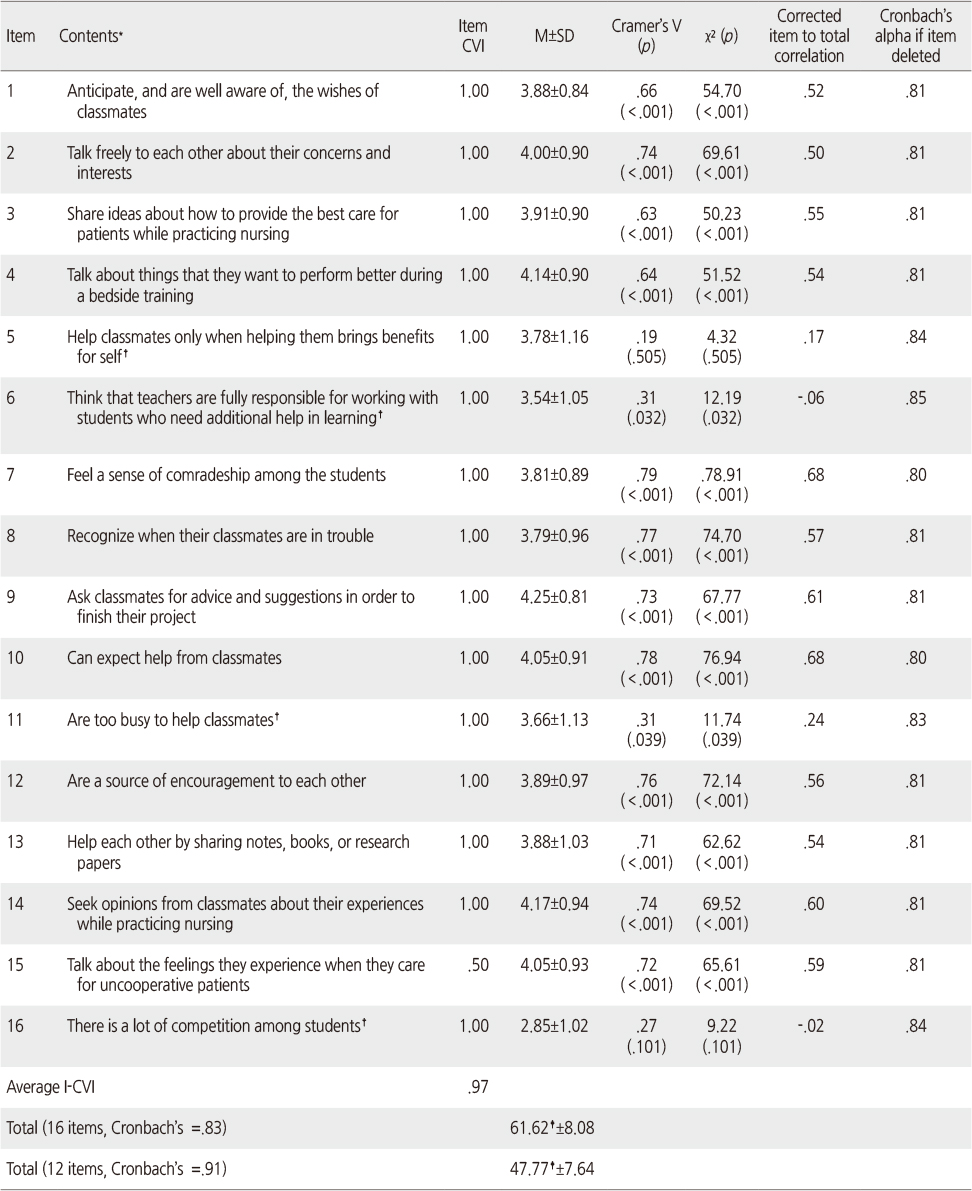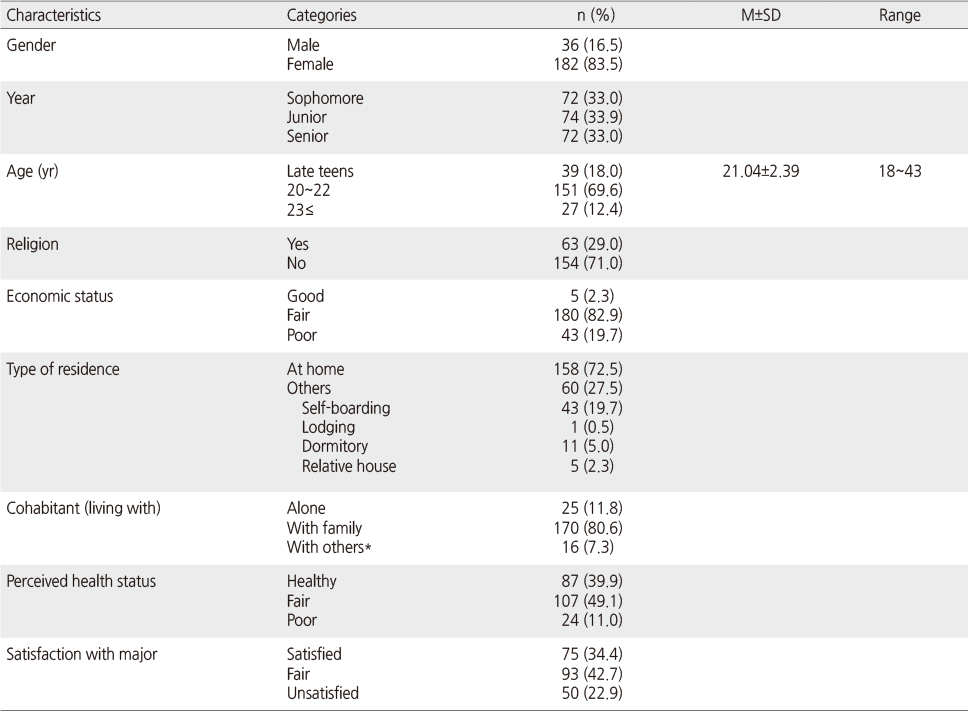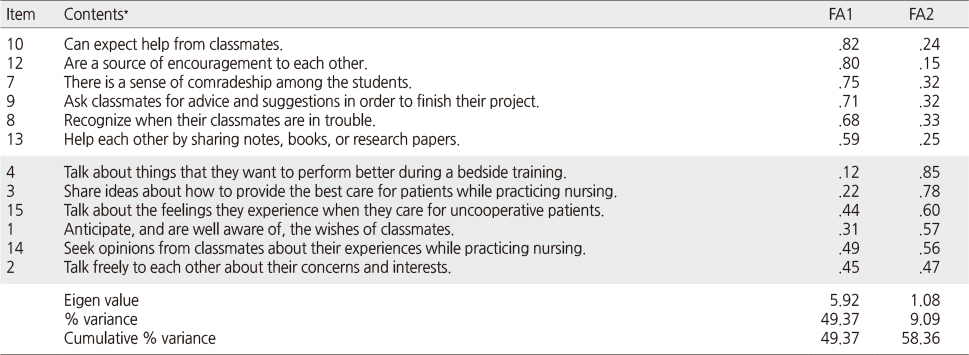Articles
- Page Path
- HOME > J Korean Acad Nurs > Volume 46(3); 2016 > Article
-
Original Article
- Validity and Reliability of the Peer Group Caring Interaction Scale-Korean Version
- Jeong-Hee Kim, Moon Yeon Kong, Yun Hee Oh
-
Journal of Korean Academy of Nursing 2016;46(3):431-442.
DOI: https://doi.org/10.4040/jkan.2016.46.3.431
Published online: June 30, 2016
1College of Nursing, Jeju National University, Jeju, Korea.
2Department of Nursing, Jeju Halla University, Jeju, Korea.
- Address reprint requests to: Kim, Jeong-Hee. College of Nursing, Jeju National University, 102 Jejudaehakno, Jeju-si, Jeju Special Self-Governing Province 63243, Korea. Tel: +82-64-754-3884, Fax: +82-64-702-2686, snukjh@jejunu.ac.kr
© 2016 Korean Society of Nursing Science
This is an Open Access article distributed under the terms of the Creative Commons Attribution NoDerivs License. (http://creativecommons.org/licenses/by-nd/4.0/) If the original work is properly cited and retained without any modification or reproduction, it can be used and re-distributed in any format and medium.
Abstract
-
Purpose
- This paper was conducted to validate the Korean version of the Peer Group Caring Interaction Scale (PGCIS-K) that measures caring behaviors as experienced by nursing students.
-
Methods
- Translation of the PGCIS-K was validated through forward-backward translation methods. Survey data were collected from 218 nursing students in a nursing school. Construct validity and criterion-related validity were evaluated. Internal consistency and the Guttman split-half coefficient were calculated to assess reliability.
-
Results
- The PGIS-K showed reliability except for 4 items (Cronbach's α=.91, Guttman split-half coefficient=.85), which were low (<.30) or negatively correlated with the total scale. A 12-item reduced form of the PGCIS-K was developed by item-analysis and construct validity evidence. Factor loading for the 12 items on 2 factors ranged from .47~.82, which explained 58.4% of the total variance. Two factors were named 'modeling and assistance (Cronbach's α=.87)' and 'communication and sharing (Cronbach's α=.82)'. Convergent validity, discriminant validity, and criterion validity were supported according to the correlation coefficients of the 2 factors with other measure.
-
Conclusion
- The findings suggest preliminary evidence that the 12-item PGCIS-K can be used to measure nursing students' peer group caring interactions in Korea. Additional studies are recommended to continue the psychometric evaluation of this scale. Also, it can be extended to measure graduate nursing students or staff nurses' peer group caring interaction.
This research was supported by the 2015 scientific promotion program funded by Jeju National University.
The authors declared no conflict of interest.
- 1. Coates C. The evolution of measuring caring: Moving toward construct validity. In: Watson J, editor. Assessing and measuring caring in nursing and health science. New York, NY: Springer Publishing; 2002. p. 215–241.
- 2. Watson J. Overview. In: Watson J, editor. Assessing and measuring caring in nursing and health sciences. 2nd ed. New York, NY: Springer Publishing; 2009. p. 3–23.
- 3. Turkel MC, Ray MA. Creating a caring practice environment through self-renewal. Nurs Adm Q. 2004;28(4):249–254.ArticlePubMed
- 4. Boykin A, Schoenhofer SO. Nursing as caring: A model for transforming practice [Internet]. Boston, MA, Jones and Bartlett Publishers. 2013;cited 2015 October 18. Available from: http://www.gutenberg.org/files/42988/42988-pdf.pdf?session_id=bf87cac6a873e095e0f5c9100586355feca0bb1a
- 5. Boykin A, Schoenhofer SO. The role of nursing leadership in creating caring environments in health care delivery systems. Nurs Adm Q. 2001;25(3):1–7.Article
- 6. Beck CT. Quantitative measurement of caring. J Adv Nurs. 1999;30(1):24–32.ArticlePubMedPDF
- 7. Coates C. The evolution of measuring caring: Moving toward construct validity. In: Watson J, editor. Assessing and measuring caring in nursing and health science. 2nd ed. New York, NY: Springer Publishing; 2009. p. 261–265.
- 8. Hughes L. Peer group interactions and the student-perceived climate for caring. J Nurs Educ. 1993;32(2):78–83.ArticlePubMed
- 9. Longo J. Acts of caring: Nurses caring for nurses. Holist Nurs Pract. 2011;25(1):8–16. PubMed
- 10. Noddings N. Caring: A feminine approach to ethics & moral education. Berkeley, CA: University of California Press; 1984.
- 11. Hughes LC. Development of an instrument to measure caring peer group interactions. J Nurs Educ. 1998;37(5):202–207.ArticlePubMed
- 12. Hughes LC, Kosowski MM, Grams K, Wilson C. Caring interactions among nursing students: A descriptive comparison of 2 associate degree nursing programs. Nurs Outlook. 1998;46(4):176–181.ArticlePubMed
- 13. Hughes LC, Romick P, Sandor MK, Phillips CA, Glaister J, Levy K, et al. Evaluation of an informal peer group experience on baccalaureate nursing students' emotional well-being and professional socialization. J Prof Nurs. 2003;19(1):38–48. ArticlePubMed
- 14. Longo J. The relationships between manager and peer caring to registered nurses' job satisfaction and intent to stay. Inter J Hum Caring. 2009;13(2):26–33.Article
- 15. Pfeiffer JA, Wickline MA, Deetz J, Berry ES. Assessing RN-to-RN peer review on clinical units. J Nurs Manag. 2012;20(3):390–400. ArticlePubMed
- 16. Hughes LC. Peer group caring interaction scale and organizational climate for caring questionnaire. In: Watson J, editor. Assessing and measuring caring in nursing and health science. 2nd ed. New York, NY: Springer Publishing; 2009. p. 149–161.
- 17. Hughes LC. (School of Nursing, University of North Carolina, Chapel Hill, RN). The organizational climate for caring questionnaire: psychometric properties. [date unknown]. 2 leaves. Availability located at: Author's individual collection.
- 18. Gabbert WL. Beyond online: Enhancing caring and professional practice in nursing education. Inter J Hum Caring. 2008;12(2):68–80.Article
- 19. Cossette S, Pepin J, Côté JK, de Courval FP. The multidimensionality of caring: a confirmatory factor analysis of the caring nurse-patient interaction short scale. J Adv Nurs. 2008;61(6):699–710. ArticlePubMed
- 20. Streiner DL, Norman GR, Cairney J. Health measurement scales: A practical guide to their development and use. 5th ed. New York, NY: Oxford University Press; 2015. p. 19–130.
- 21. Polit DF, Beck CT. Nursing research: Generating and assessing evidence for nursing practice. 9th ed. Philadelphia, PA: Lippincott Williams & Wilkins; 2012. p. 200–485.
- 22. Tigges BB. Psychometric properties of the social comparison motives scale. J Nurs Meas. 2009;17(1):29–44.ArticlePubMedPMC
- 23. Terwee CB, Bot SD, de Boer MR, van der Windt DA, Knol DL, Dekker J, et al. Quality criteria were proposed for measurement properties of health status questionnaires. J Clin Epidemiol. 2007;60(1):34–42. ArticlePubMed
- 24. Kelley T, Ebel R, Lincare JM. Item discrimination indices. Rasch Meas Trans. 2002;16(3):883–884.
- 25. Ferketich S. Focus on psychometrics. Aspects of item analysis. Res Nurs Health. 1991;14(2):165–168.ArticlePubMed
- 26. Rattray J, Jones MC. Essential elements of questionnaire design and development. J Clin Nurs. 2007;16(2):234–243. Article
- 27. Hwang KJ. Sung confucian ethics and education of care-based on Noddings' view. In: Hwang KJ, Kim SH, Park WJ, Cho KR, Lee SI, Baek MJ, , editors. Korean cultural tradition and ethics of care. Seongnam: The Academy of Korean Studies Press; 2015. p. 19–52.
- 28. Cho GH. What is Korean collectivism?. In: Kim MC, Ghang TJ, Kim GH, Kim GI, Kim WB, Kim JG, , editors. Korean, Who are you?. Paju: Book 21; 2013. p. 153–171.
- 29. Lee YJ. Multivariate analysis using SPSS/PC+. Seoul: Sukjungbooks; 1993. p. 39–130.
REFERENCES
Item-CVI, Means, and Item Analysis of the PGCIS-K (N=218)

*Most items began with 'Students at this school'; †Reverse scored items; ‡Mean of total; I-CVI=item-level content validity index; Scale-level CVI, averaging method (S-CVI/Ave)=.97; The 16-item PGCIS' M±SD of items=3.85±0.51, the 12-item PGCIS' M±SD of items=3.98±0.64; Numbers in bold style=four items were low (<.30) or negative correlations with the total scale; Range of skewness of items=-0.82~0.31; Kurtosis of items=-0.70~1.64; Range of ceiling effects of items=0.5~5.0%; Floor effects of items=0.9~8.3%.
Figure & Data
REFERENCES
Citations

- Peer caring and clinical adaptation as mediators between emotional intelligence and nursing professionalism in students
SeolHwa Moon, Sun Young You, Juyeon Oh
Teaching and Learning in Nursing.2025;[Epub] CrossRef - Hospital organisational health as a mediator between positive nursing organisational culture, caring behaviour, and quality of nursing care
Bo Ram Ku, Mi Yu
Humanities and Social Sciences Communications.2024;[Epub] CrossRef - A structural model of nursing students’ performing communication skills
Cho Rong Gil, Kyung Mi Sung
The Journal of Korean Academic Society of Nursing Education.2023; 29(2): 148. CrossRef - Adapting and Validating the COVID-19 Vaccine Hesitancy and Vaccine Conspiracy Beliefs Scales in Korea
Hyesung Ock, Mihyeon Seong, Insook Kim
Healthcare.2022; 10(11): 2274. CrossRef - Influence of Nurse Manager and Peer Group Caring Behaviors as Perceived by Nurses on Organizational Socialization and Nursing Performance
Na Yeon Shin, Soyoung Yu, Seong Suk Kang, Seung Shin Lee, Min Jeung Park, DaeYeon Lee, Sun Mi Nam
Journal of Korean Academy of Nursing Administration.2020; 26(2): 110. CrossRef - A Review of the Korean Nursing Research Literature with Focus on Quantitative Measurement of Caring
Jeong-Hee Kim, Young Sook Park
Journal of Korean Academy of Community Health Nursing.2018; 29(2): 155. CrossRef - Influence of Nurse Manager and Peer Group Caring Behaviors as Perceived by Nurses on Intention to Retention
Moon Yeon Kong, Jeong-Hee Kim
Journal of Korean Academy of Nursing Administration.2017; 23(2): 191. CrossRef
General Characteristics of the Participants (N=218)
*Friends, senior, or junior.
Item-CVI, Means, and Item Analysis of the PGCIS-K (N=218)
*Most items began with 'Students at this school'; †Reverse scored items; ‡Mean of total; I-CVI=item-level content validity index; Scale-level CVI, averaging method (S-CVI/Ave)=.97; The 16-item PGCIS' M±SD of items=3.85±0.51, the 12-item PGCIS' M±SD of items=3.98±0.64; Numbers in bold style=four items were low (<.30) or negative correlations with the total scale; Range of skewness of items=-0.82~0.31; Kurtosis of items=-0.70~1.64; Range of ceiling effects of items=0.5~5.0%; Floor effects of items=0.9~8.3%.
Final Descriptive Statistics and Reliability Estimates of the 12-item PGCIS-K (N=218)
*Deleted item 5, 6, 11, & 16 from the 16-item PGCIS-K; FA1=Modeling & assistance; FA2=Communication & sharing.
Factor Loadings ≥.40 from the Rotated Pattern Matrix for the 12-item PGCIS-K (N=218)
*Most items began with "Students at this school"; FA1=Modeling & Assistance; FA2=Communication & Sharing; Numbers in bold style=loaded well on both factors with a split loading of>.40 for FA1 and FA2.
Correlations between the 12-item PGCIS-K and OCCQ (N=218)
*Correlation coefficient between FA1 & FA2, r (p)=.72 (<.001); †M±SD=3.45±0.55; FA1=Modeling & Assistance; FA2=Communication & Sharing; O_m=Modeling; O_dia=Dialogue; O_pra=Practice; O_con=Confirmation; O_un=Uncaring behaviors.
*Friends, senior, or junior.
*Most items began with 'Students at this school'; †Reverse scored items; ‡Mean of total; I-CVI=item-level content validity index; Scale-level CVI, averaging method (S-CVI/Ave)=.97; The 16-item PGCIS' M±SD of items=3.85±0.51, the 12-item PGCIS' M±SD of items=3.98±0.64; Numbers in bold style=four items were low (<.30) or negative correlations with the total scale; Range of skewness of items=-0.82~0.31; Kurtosis of items=-0.70~1.64; Range of ceiling effects of items=0.5~5.0%; Floor effects of items=0.9~8.3%.
*Deleted item 5, 6, 11, & 16 from the 16-item PGCIS-K; FA1=Modeling & assistance; FA2=Communication & sharing.
*Most items began with "Students at this school"; FA1=Modeling & Assistance; FA2=Communication & Sharing; Numbers in bold style=loaded well on both factors with a split loading of>.40 for FA1 and FA2.
*Correlation coefficient between FA1 & FA2, r (
 KSNS
KSNS
 E-SUBMISSION
E-SUBMISSION




 Cite
Cite

